Automated webinar funnels are incredibly powerful sales tools for generating revenue on autopilot — but only if they're built properly.
The recipe for building an automated webinar funnel that can consistently turn leads into sales has five ingredients:
-
Drive targeted traffic to a landing page
-
Get visitors to register for the webinar
-
Get registrants to attend the webinar
-
Get attendees to purchase the product or service
-
Follow up with attendees who didn't purchase to get them to convert
Here's a visualization of what the automated webinar funnel journey looks like:
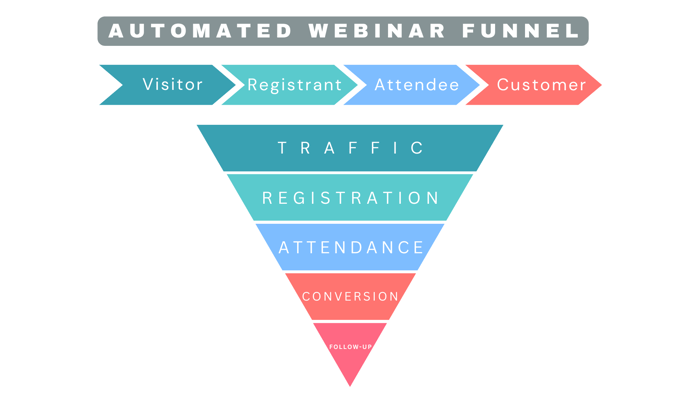
Knowing what the five stages are and moving actual people through them are two different things — so we'll focus the latter part of this guide on the strategic execution aspect.
Note: While most of the strategies we cover in this guide can be applied to webinars on other platforms, we will reference our product, eWebinar, simply because that's the software we're most familiar with. If any feature we mention is exclusive to us, we'll be sure to let you know.
Let's dive in!
The five stages of an automated webinar funnel
Note: If you’re still not sure whether building an automated webinar funnel will be worth the time and effort then click here to skip to the section on its benefits.
We listed the five stages to turn a website visitor into a paying customer in the intro so now let's dive deeper into each step. In the next section, we'll also walk you through specific strategies that you can use if you run into problems within any stage of your automated webinar funnel.
1. Drive traffic to the registration page
Note: If you are already driving a lot of (targeted) traffic to your webinar landing page then you can skip to the second stage.
The first course of action is to actually get people into the top of your automated webinar funnel. In practice, this means driving traffic to your webinar registration page. There are countless ways to do this like content marketing, social media, paid ads, and cross-promotion.
Here are the most common channels:
-
Email marketing
-
Partnerships
-
Paid ads
-
Social media
-
Re-engaging existing customers
If you're looking for more options then read our full guide on 25 Ways to Promote An On-Demand Evergreen Webinar!
2. Get visitors to register
Getting visitors to your webinar landing page is only half the battle — they still need to actually register. Your registration page should speak about the specific problems and unique benefits that people will get by attending your webinar.
Remember, you're not trying to sell everything to everyone or summarize the full contents of your presentation — so just focus on highlighting the key outcomes for your ideal customers.
Here are a few best practices to bear in mind when building your registration page:
-
Audience. Who's your audience, where did they come from, which goals do they have, and what do they think about you (if anything)? Understanding which problems they’re facing and which traffic source they came from will help you hook them into registering.
-
Emotions. Every website visitor needs to go on an emotional journey before they decide to register for your webinar. Agitate their frustrations, tease the desired outcome, and then explain how you'll get them there while positioning yourself as a trusted authority.
-
Questions. Is this the right presentation for me, who's hosting it, can I trust what they're saying, and where can I watch it? If you answer all these questions then your visitors will be far more likely to register for the webinar you’re offering.
To learn more about these strategies, read our full guide on How to Create a High-Converting Webinar Landing Page!
3. Increase attendance rates
Driving registrations is a great start but it's not yet time to rest on your laurels.
The industry average attendance rate for live webinars is 40% while our customers average 65% on their automated webinars.
This means that the simple act of switching from live to automated will significantly improve your attendance rates by virtue of making sessions more convenient to attend. (We’ll explain why below.)
However, there's always room to improve further and push beyond the 65% average on our platform. The secret to increasing attendance rates is offering diverse and flexible scheduling options on your webinars.
In fact, some eWebinar customers routinely get attendance rates in the 80% to 90% range:
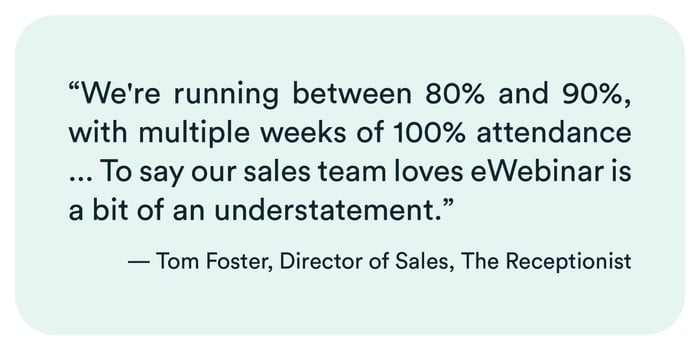
Read The Receptionist case study →
eWebinar lets you choose from three webinar scheduling options:
-
On-demand webinars. Enabling on-demand sessions will let leads watch your webinar at their peak moment of interest instead of having to wait until later. You can use just-in-time webinars to display a countdown timer for a session starting within five minutes of a visitor landing on the page.
-
Recurring webinars. Running automated webinars on a recurring schedule will help you capture leads who don't have the time to watch your webinar immediately. Because registrants can book a date on their calendar, you'll get the same commitment level as a live webinar.
Tip: You can enable dynamic time zones — which lets you offer your webinars at the same time of day regardless of which time zone an attendee is in — to ensure that sessions always run at convenient times for registrants around the world -
Webinar replays. Giving registrants the option to watch webinar replays (with the same live chat and interaction features) will increase overall attendance rates. If you want to maintain a sense of urgency, you can set replay links to expire or only send them to registrants who missed a session.
We'd recommend that you have all three options active at once. In fact, we're one of a few pre-recorded webinar platforms that let you enable all three options simultaneously (which is why our customers' attendance rates outperform live webinars by such a wide margin).
If you follow the best practices here then you're bound to surpass our platform's 65% average webinar attendance rate.
4. Optimize conversion rates
After all the work put into driving visitors to your landing page, getting them to sign up, and then ensuring they attend, it's time to secure your ROI by converting them into paying customers. If you deliver genuine value during your presentation, there'll always be a decent number of conversions.
A few things that can increase your conversion rate include:
-
Following the 80/20 rule (spending 80% of the webinar covering the topic and 20% pitching)
-
Testing different CTAs on live attendees and then using the winner in your automated webinar
-
Adding offer popups with clickable CTA buttons
To learn more, read our full guide on How to Craft High-Converting Webinar CTAs [Examples + Best Practices]
Of course, a well-optimized CTA is useless if no one gets that far in your webinar (or has already lost interest by the time it rolls around) Using a proven webinar structure to keep your attendees watching and engaged until you make the ask is absolutely crucial.
One option would be to use our five-stage on-demand demo structure!
5. Post-webinar follow-up
Following up with the same CTA after the webinar can help you convert potential customers who might still be on the fence. Not everyone will be ready to convert by the time they reach the bottom of your funnel so re-engaging these warm leads should be a top priority.
The good news is that the days of manually sending a follow-up email to each attendee are behind us. Automating the follow-up process is really easy with our built-in post-webinar email sequences and integrations with tools like Mailchimp or Zapier for longer-term lead nurturing.
We’ll dive deeper into the importance of follow-ups later and best practices you should follow in another section below. In the meantime, feel free to check out our guide on How to Write Webinar Follow-Up Emails That Get Results!
Automated Webinar Funnel Diagnosis: Identifying Problems
While setting up your funnel is time-consuming, the real challenge — which produces the biggest ROI — is optimizing its performance. Fortunately, you only have to optimize it once and then watch the revenue roll in on autopilot from there.
If your automated webinar funnel isn't producing the results you hoped for, the first step is to figure out which stage is failing you. The most straightforward way to identify which stage(s) the problem lies in would be to look at the drop-off rates for each stage of the funnel.
eWebinar's analytics can show you the registration, attendance, and conversion rate for your webinar:
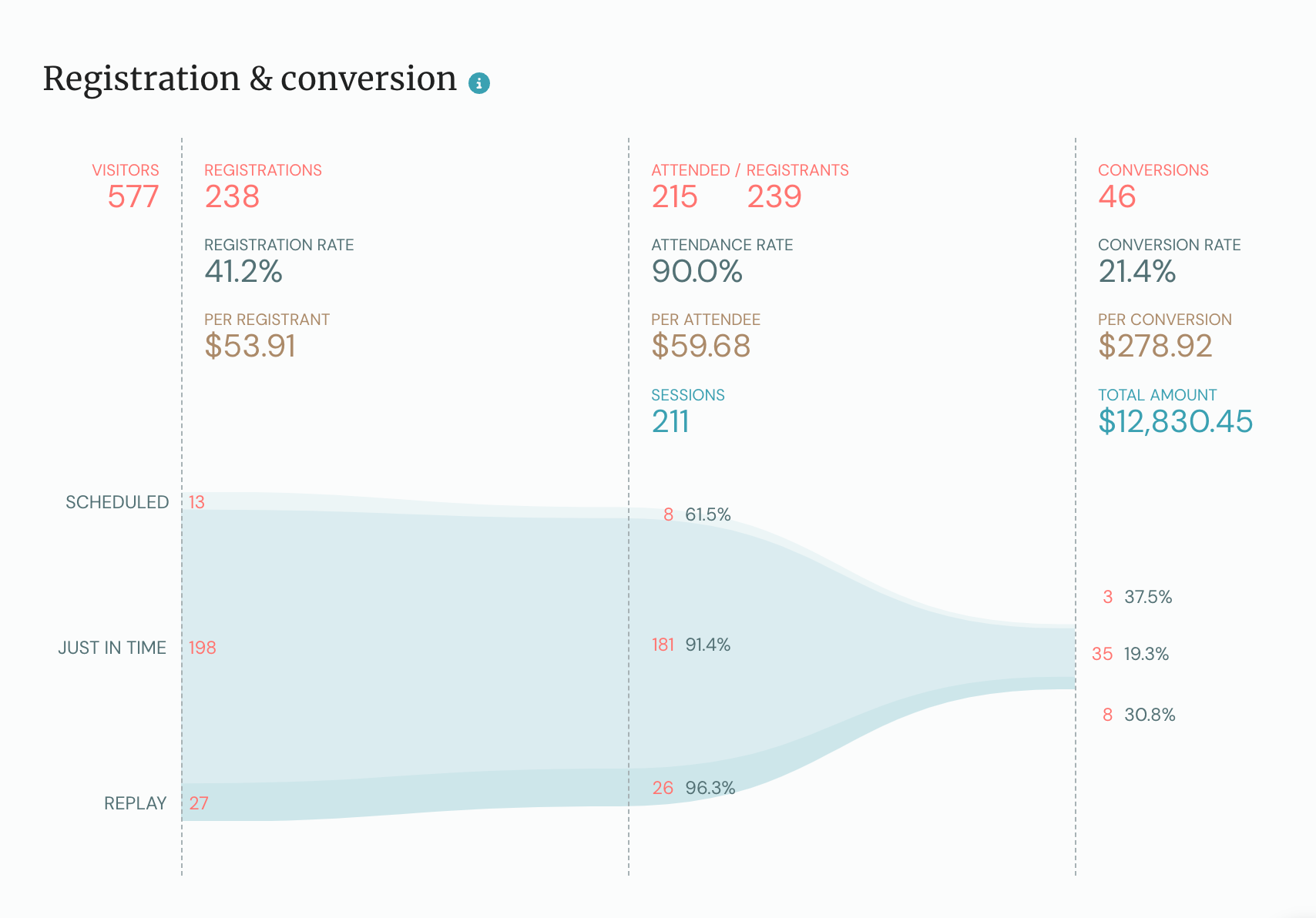
If you're using another automated webinar then your analytics dashboard may look different. Certain automated webinar software may not automatically calculate registration rates either — in which case you should calculate manually to see which funnel stage has the highest drop-off rate.
For example, you could divide the total number of unique visitors on your landing page by the number of webinar registrants for the same period. This will help you determine your registration rate manually if your webinar platform doesn't calculate that metric automatically.
Here's how to improve each stage of the webinar after you've pinpointed the problem:
Traffic
A lack of traffic is a common and challenging problem you’ll need to address since it means that not enough prospects are coming into the top of your funnel. The solution would be to double down on the highest-volume channels (without sacrificing relevancy) to get more relevant leads.
This could entail:
-
Collaborating with partners who can cross-promote to your target audience
-
Creating lots of blog posts (but maintaining a narrow focus on relevant topics)
-
Increasing ad spend* (to increase paid traffic without broadening audience settings)
*You should only increase ad spend once you’ve already proven that your funnel converts to avoid wasting money
Keeping traffic targeted even as you scale up is paramount. If you have the right pages but drive the wrong leads to them then you’ll get fewer conversions (despite the wider reach).
In fact, pushing more traffic toward the top of your funnel is probably what you’ll be spending most of your time on once the other stages are well-optimized. To learn about more ways to do that, read our full guide on 25 Ways to Promote An On-Demand/Evergreen Webinar.
Registration
Low registration rates usually mean that the copy on your landing page didn't resonate with visitors and wasn't compelling enough to get them to register. However, as explained in the previous section, it's also possible that the traffic itself wasn't targeted enough so don't automatically assume that low registration rates are the landing page's fault.
There are a few things you can do to improve conversions on your registration page.
First, you'll want to make sure that the page is structured according to the emotional stages that visitors must pass through before signing up for your webinar:
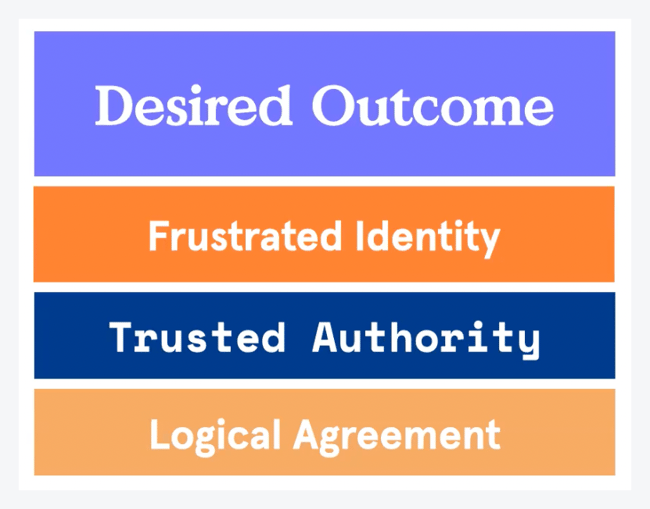
Here are the four stages (and how to leverage them to drive registrations):
-
Desired outcome. Every visitor has to get an immediate sense that your webinar will get them to their desired outcome — whether that's earning money, saving time, or growing their business.
-
Frustrated identity. You need to show visitors that you understand the pain points they're dealing with and the challenges that are keeping them from their desired outcome.
-
Trusted authority. Visitors will need to believe that you're the right person — whether due to experience, skill, or a product — to help them solve the problem they're dealing with.
-
Logical agreement. It should be evident that you'll be able to deliver the promised solution through a structured and proven method.
If you’re writing a new registration page from scratch then here are three things to consider:
-
Align your goals. Instead of thinking about your business goals, the text/images/videos on your landing page should reflect your audience's goals — i.e. the problem they're trying to solve (and are willing to pay for).
-
Define the audience. While your offer might appeal to a broad audience, it's nearly impossible to write compelling copy for such a diverse group. The narrower your target audience is, the more specific (and therefore compelling) your landing page will become.
-
Decide on a CTA. Understanding your CTA (the primary offer you'll make in your webinar) will set the tone for the rest of the landing page. Whether it's qualifying leads, selling a product, or getting students to enroll in your program you should set up that CTA as early as the registration page.
Lastly, if you determine that the problem is the traffic you're attracting rather than the landing page itself then you'll need to go back to stage one and re-target the lead generation channels.
To learn more read our full guide on How to Create a High-Converting Webinar Landing Page!
Attendance
Three reasons account for the majority of missed webinars:
-
Forgotten sessions. The webinar slipped the registrant's mind causing them to miss the scheduled session.
-
Scheduling conflicts. A scheduling conflict came up that made the registrant decide to skip the webinar.
-
Loss of interest. If people have to wait a week or month to attend a live webinar then they might lose interest or have a change of heart by the time it runs.
The easiest way to overcome all three of these obstacles is to offer your webinar on-demand (which is one of the main benefits of an automated webinar).
When it comes to attendees losing interest, the simple solution is to offer on-demand webinars so registrants can watch at their peak moment of interest instead of having to wait for a live session.
If people can't attend your webinar right away, you can also offer your webinar on a recurring schedule so that they can sign up for a convenient time on their calendar. This helps you capture leads that aren’t ready to watch a presentation so you don’t lose the prospect.
To ensure that registrants don’t forget about the scheduled session they signed up, you’ll need to up your reminder game. The most effective way to do this is by creating automated email sequences that remind registrants in the days, hours, or minutes leading up to a webinar.
For example, eWebinar lets you set up reminder notifications for an upcoming webinar through email or SMS/WhatsApp via Twilio. You can also send reminders via multiple channels at different times (e.g. an email the day before and then a text message in the final 15 minutes).
Tip: You should remind them of the reason(s) they registered in the first place.
As for scheduling conflicts, you can work around these by giving your registrants more flexibility and options over when they can watch your webinar. eWebinar has a dynamic time zone feature that can adjust session schedules based on the registrant's time zone.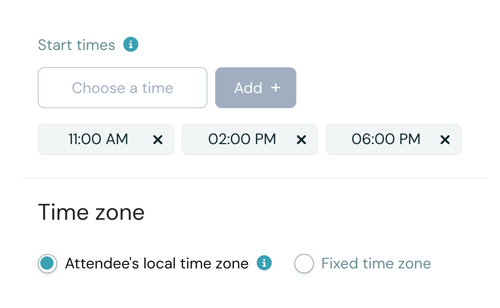
If the automated webinar platform you use has an equivalent option then you'll want to enable that to ensure you can reach prospects across the globe.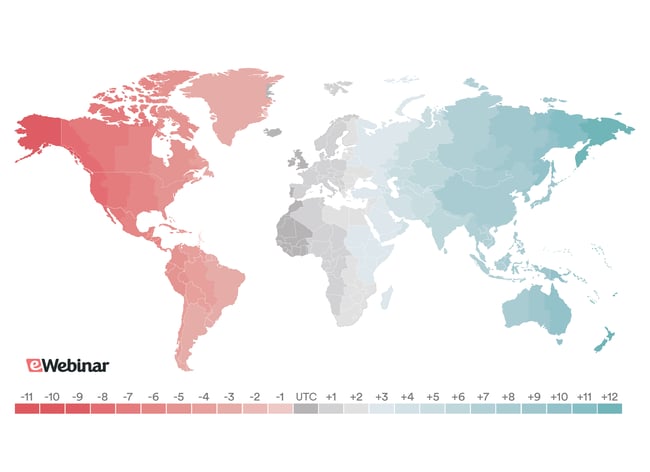
You should also consider enabling on-demand webinar replays and sending links to registrants who missed a session.
This will ensure that they're still able to watch the content even if they miss their scheduled slot.
Conversion
If people are registering and attending but not converting then you'll want to make sure that the offer and content themselves are good. This is why we usually recommend testing your script and presentation on live attendees before you automate the webinar.
Assuming the offer or content isn't the problem, the way you structured your presentation may be the culprit behind subpar conversion rates. Using an effective webinar formula that not only keeps attendees engaged until the end but warms them up for the ask is incredibly important.
One high-converting example is our five-stage on-demand demo structure:
-
Agenda. Take 30-60 seconds to introduce yourself, outline what you plan to cover, and tease how your solution is unique or better than alternatives. The agenda sets the attendee's expectations and puts them in a mindset to listen carefully.
-
Backstory. Share the problem you experienced and how that drove you to solve it with your product or service. This is your chance to agitate their pain points while building yourself up as a trusted authority at the same time.
-
Competition. Demonstrate why your solution needs to exist by highlighting the shortcomings of existing software. This is where you should take the time to explain the problem in greater depth and go over the specific issues that it causes.
-
Solution. Once your audience understands the problem and trusts you, it’s time to reveal the solution. Some webinar hosts tease the solution throughout the entire presentation but then lock it behind a paywall — NEVER DO THIS!
-
CTA. Ask for the close and tell attendees what the next action they should take is.
There are plenty of best practices for writing a compelling CTA and numerous types of CTAs you could use. To get a more detailed explanation, read the full guide we mentioned earlier on How to Craft High-Converting Webinar CTAs [Examples + Best Practices]
If you’re using a proven presentation structure but attendees are still leaving before the CTA then there are a few tactical changes you can make to improve conversions:
-
Shorten the webinar length (requires re-recording)
-
Deliver your CTA earlier (requires re-recording)
-
Keep attendees engaged longer with interactions
The first two options require that you re-record — which is a lot of work to put in without any guarantee of higher conversion rates. On the other hand, keeping attendees engaged long enough to reach the point where the CTA shows up can be done by adding interactions.
Which interactions are available to you will depend on the automated webinar platform that you use.
On eWebinar, you can choose from 20+ interactions including polls, questions, quizzes, contact forms, special offers, and other popups that will prompt them to participate in the webinar — keeping them engaged until the end to ensure they don't leave early.
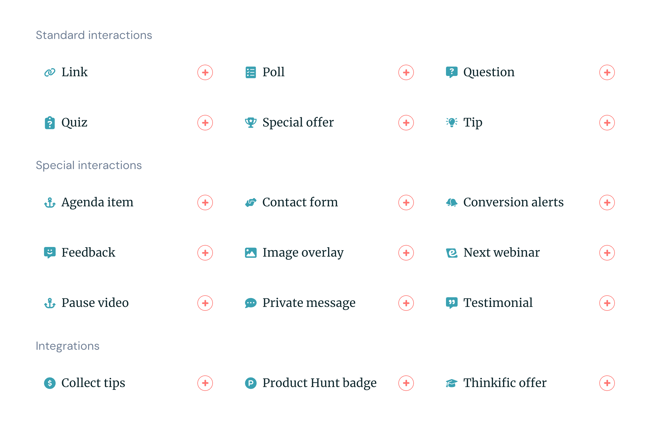
Adding these interactions right before the drop-off point in your presentation can revitalize your attendees and keep them interested long enough to hear your CTA at the end. With eWebinar you can even display personalized popups that adapt based on the attendee's response to previous interactions.
Finding out when people are leaving is actually really easy on eWebinar since our engagement heatmap shows where attendees drop off:
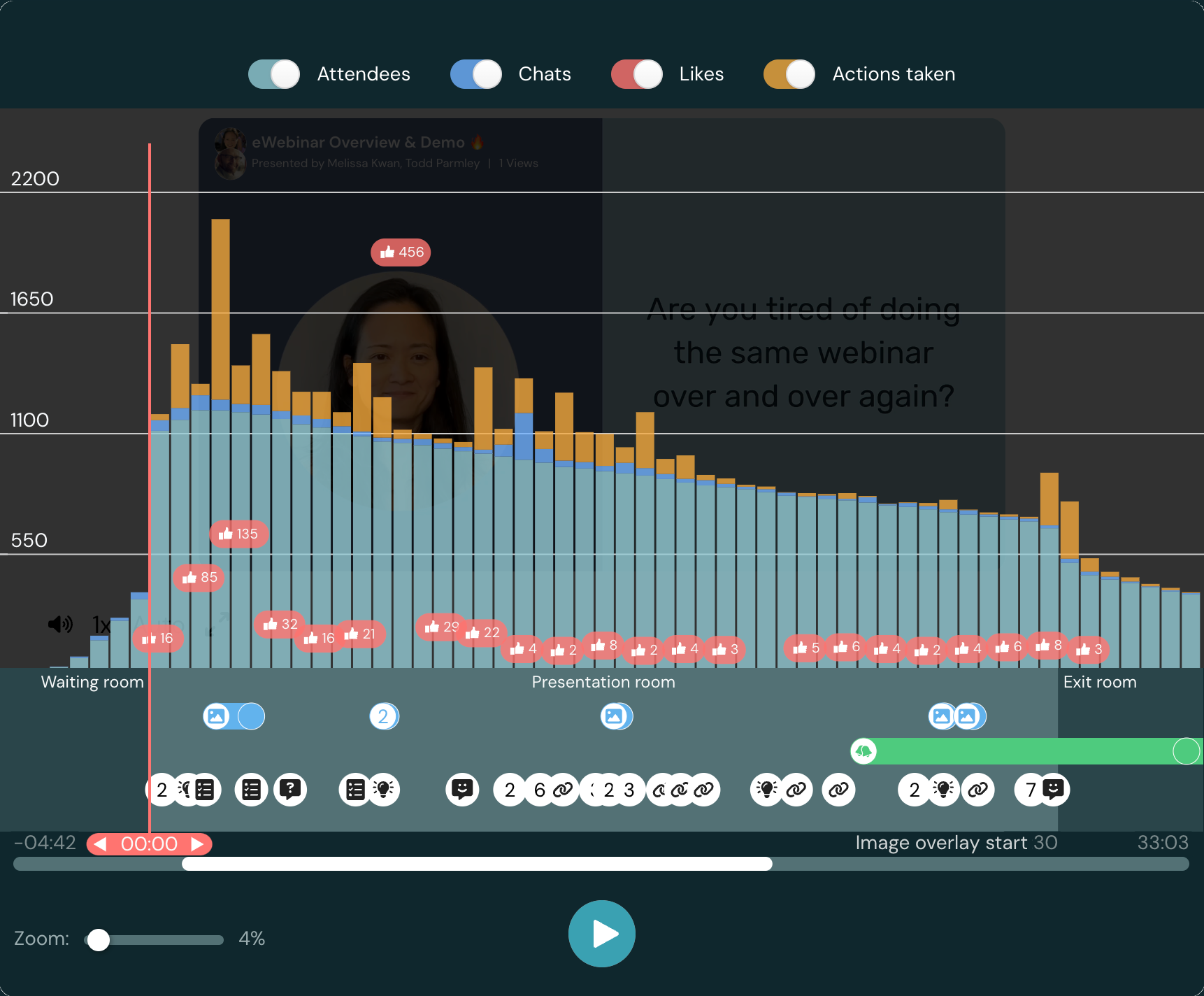
If you’re using another automated webinar software then refer to the product documentation to see if they have an equivalent analytics dashboard.
The importance of follow-ups
Even if your core webinar metrics — traffic, registration, attendance, and conversion — are good you'll still be leaving money on the table if you fail to follow up with leads that didn't convert during the webinar itself. In fact, honing your follow-up efforts can be a great way to optimize underperforming webinars.
Think about these follow-up emails as fishing lines that recapture leads who escaped the funnel.
Every webinar template on the eWebinar gallery includes an automated follow-up email sequence.
There are three factors that determine the effectiveness of a follow-up email:
-
Personalization. Segment your follow-up emails between registrants who didn't attend, left early, or watched the full webinar to keep it relevant. Those who missed the webinar would love a replay link but rehashing the same information to attendees who finished the session would bore them.
-
Consistency. Make sure you use the same CTA that you pitched attendees on during your webinar. Making different or additional offers will confuse them at best and make them feel baited at worst.
-
Hook. No matter how good the body text and CTA are, it won't matter if the subject line isn't compelling enough to get recipients to open it. Mentioning replay links or bonus materials in the subject line will help you hook recipients in.
If you want to learn more about follow-up best practices then read Sam Bowman's full guide on How to Write Webinar Follow-Up Emails That Get Results and check out the templates he uses.
Tips and best practices for automated webinar funnels
Here's a list of some tips and best practices that can help you get the most out of our automated webinar funnel:
-
Scheduling. Have your webinar running on autopilot 24/7 or (at least pick the best time and day to host a webinar like one of our customers that runs them from Monday to Friday).
-
Make it free. Reduce the barrier to entry so attendees can try before they buy and experience the value firsthand (without needing to take their credit cards out).
-
Don't oversell. Spend the first 80% of your presentation helpfully covering the topic so attendees actually feel like learning more, enlisting your service, or buying a product at the end.
-
Establish authority. Display your expertise by addressing specific issues, going over what makes your solution unique/better, and mentioning past case studies or other forms of social proof.
-
Be authentic. Prioritize authenticity over perfection (it's better to fumble a few words than come off over-rehearsed).
-
Build trust. Don't lie about the webinar being live, use simulated chats with fake attendees, or tease a solution for half an hour then lock it behind a paywall at the end.
Benefits of automated webinar funnels
Once you automate the presentation itself, you’ll be able to focus your time and energy on the highest-impact tasks. Maximizing the amount of relevant traffic to the top of the funnel and the percentage of customers that come out of the bottom will become your sole focus.
Our customers have been able to double their attendance rates and triple conversion rates:
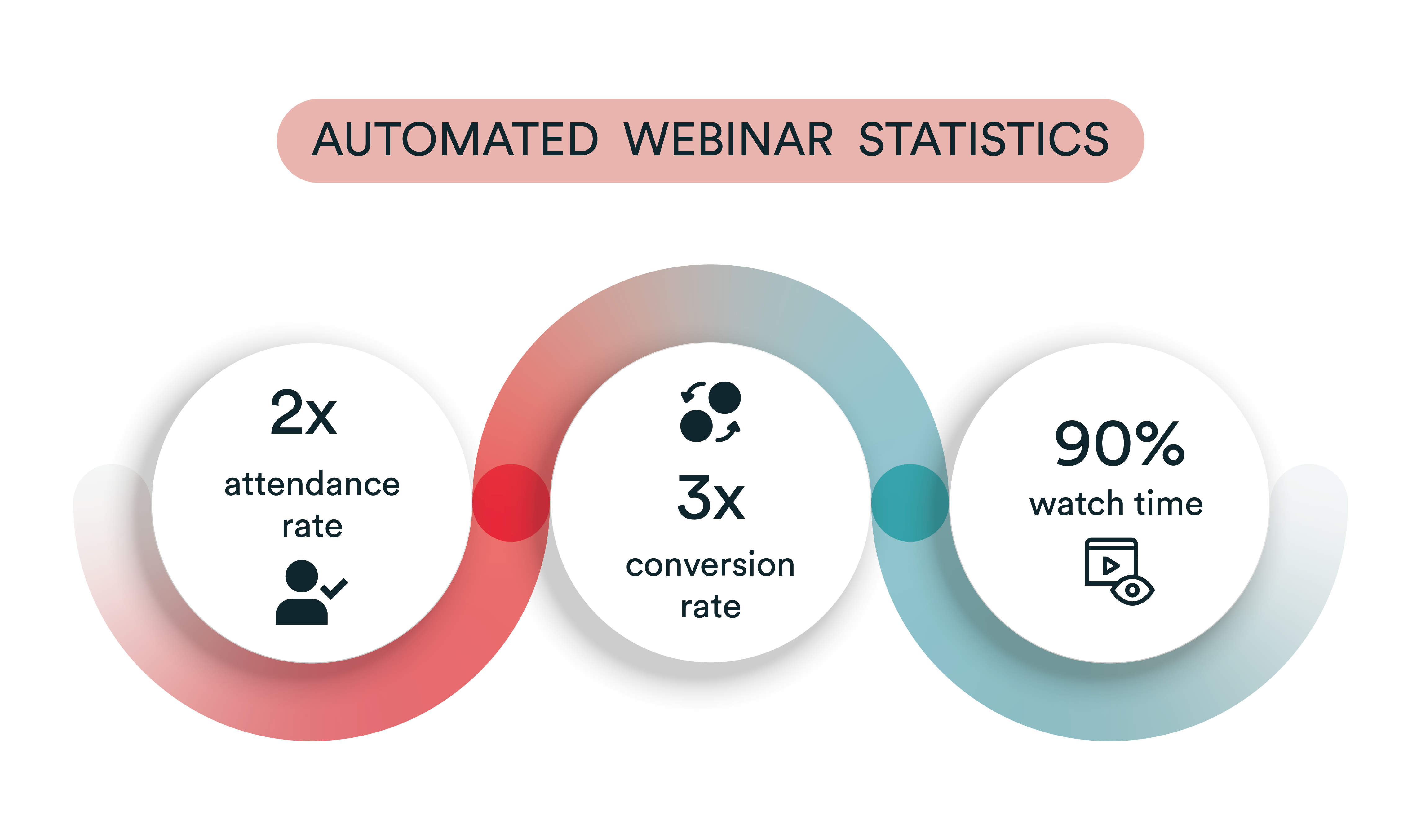
Note: These statistics are based on first-party data and our customer case studies.
In fact, 56% of marketers use webinars as a content distribution channel (according to the Content Marketing Institute).
Three main benefits of automated webinars:
-
Scalability. Your reach is no longer limited by how many sessions you're able to host or how long you can present before burning out.
-
Reliability. Automated webinars play the same video every time which means higher presentation quality, no webinar latency, and fewer technical issues.
-
Interactivity. It's more interactive because you don't need to juggle audience engagement with presenting and can schedule automated interactions ahead of time.
Let's take a closer look at each benefit and how to best capitalize on them!
Scalability
The most obvious benefit to having an automated webinar funnel is that you won't need to host live sessions yourself. Anyone who's attempted to run live webinars on a regular basis will know that it's impossible to accommodate every prospect across each time zone.
Not to mention the fact that the more webinars you host, the more exhausting they become (webinar burnout is a very real risk). These can be especially true for sessions where you're just repeating the same information over and over again — such as onboarding/training or customer success webinars.
On the other hand, automated webinars are available to interested prospects round-the-clock regardless of which time zone they're in. This massively increases your reach and allows you to engage customers at their peak moment of interest without having to get up at 3 AM in the morning.
As a result, you'll be able to scale automated sales whether you're a:
-
SaaS company trying to automate free trial signups
-
Course creator who wants to give people a taste of the learning experience
-
Financial advisor using a service overview webinar to attract new customers
-
Website selling physical products (MAGFAST was able to generate $14M in sales on autopilot)
It's always the same automated process of turning traffic into registrants, reminding them to attend, and following up with those who don't convert right away. The funnel structure or visitor journey doesn't change based on what you're selling, only the language you use does.
By hosting more sessions with higher attendance rates, you're bound to get more sales.
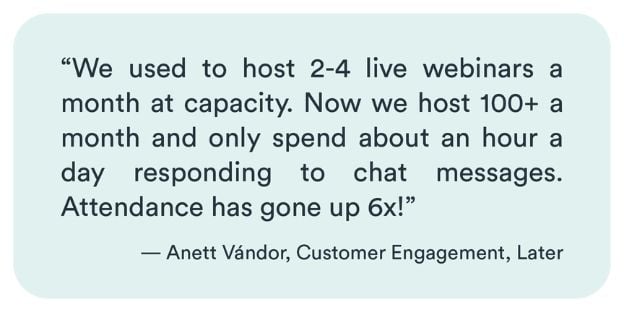
Reliability
Removing the need to host each session live doesn't just save you time and stress but also offers a more consistent experience for attendees (which will increase the odds of them converting).
After all, pre-recorded videos never have an "off day" so all you need to do is capture the best version of your presentation once and then let attendees experience that for themselves each time they sign up for your automated webinar.
Furthermore, automated webinars are immune to the technical difficulties that plague live webinars and often ruin even the most well-planned presentations. Slow internet, power outages, and random glitches can't affect automated webinars because they just play the same video over and over again.
We call these risks the Triangle of Technical Difficulties:
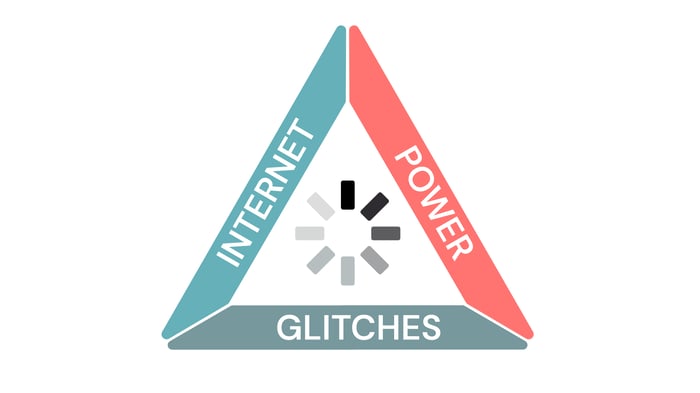
The quality of the presentation matters more than whether it's live or recorded.
This is the simple truth that allows an automated webinar sales funnel to counterintuitively outperform live sessions. We're not saying they're not good, live webinars are great for experimenting with different scripts, FAQs, and CTAs on live attendees.
However, once you've maxed out the improvements you can make on your presentation the goal should be to turn a recording of that peak presentation and increase its scalability/distribution/reach through automation.
There are many automated webinar platforms to choose from but the important thing to realize is that, by automating your presentation, you remove yourself as the single point of failure for each session. This reduces the number of things that can (and therefore will) go wrong during your webinars.
To learn more about eliminating technical difficulties through automation read our guide on How to Reduce Webinar Latency!
Interactivity
A common question we get is "Wouldn't a recorded webinar be less interactive than a live webinar?"
If you're just sending people to a static video and calling it a webinar then yes, absolutely.
But a static video isn't a webinar — much less an automated webinar — it's just a video.
We've spent the past few years ensuring that the automated webinars created on eWebinar are not only "just as interactive as live webinars" but more interactive than live webinars. There are two things that made this possible:
-
Our live chat system
-
Our interactions
eWebinar's live chat lets you join the webinar room whenever attendees are watching and communicate with them in real time (whether to answer questions or close the deal). You also have the option of replying to attendees after the webinar ends through email or a Slack channel (by using our integration).
The fact that the host doesn't need to juggle reading a script with answering questions already helps make automated webinars more interactive than live sessions. On top of that, you can pre-schedule automated interactions that show up at the right time, every time.
Most attendees just sit there and stare at the screen during live webinars. Automated webinars give them the opportunity to participate by answering polls, taking quizzes, and filling out contact forms — all without distracting the host from their presentation.
This keeps them from pulling their phone out, switching to another tab, or leaving the webinar early.
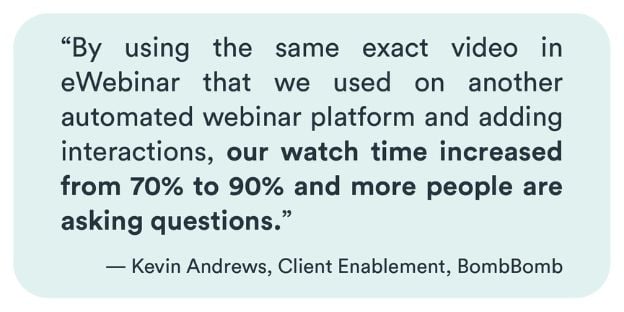
Read the BombBomb case study →
Note: Attendee responses also serve as valuable insights for sales and marketing teams.
When trying to find the right automated webinar platform or best automated webinar software for your needs, make sure to pick one that has both a live chat and multiple interactions — or read our full guide on 12 Best Automated Webinar Software Platforms
Conclusion
As you can see, the benefits that an automated webinar funnel offers are both numerous and significant.
By automating the last four steps of the five-stage funnel, you'll be able to put all your effort towards driving more qualified leads toward your registration pages to move them through the well-oiled conversion machine.
This is the power of having an automated funnel that can generate conversions on autopilot.
The best automated webinar platforms will facilitate your funnel’s success by offering flexible scheduling options for registrants, letting you engage attendees through real-time live chat, and providing a wide array of interactions to keep the audience engaged until the CTA.
If you want to experience an automated webinar for yourself then join and watch our on-demand demo:










